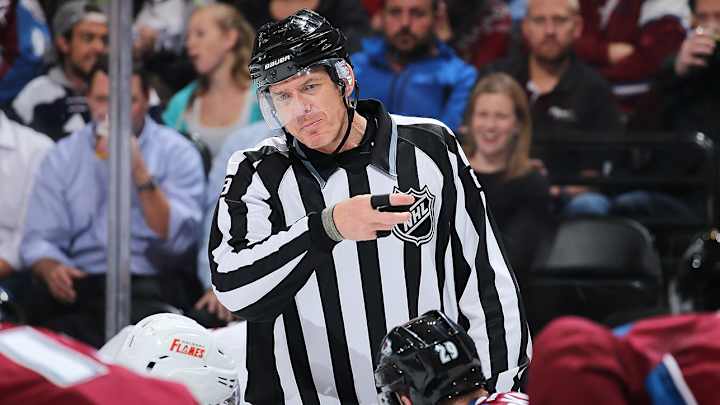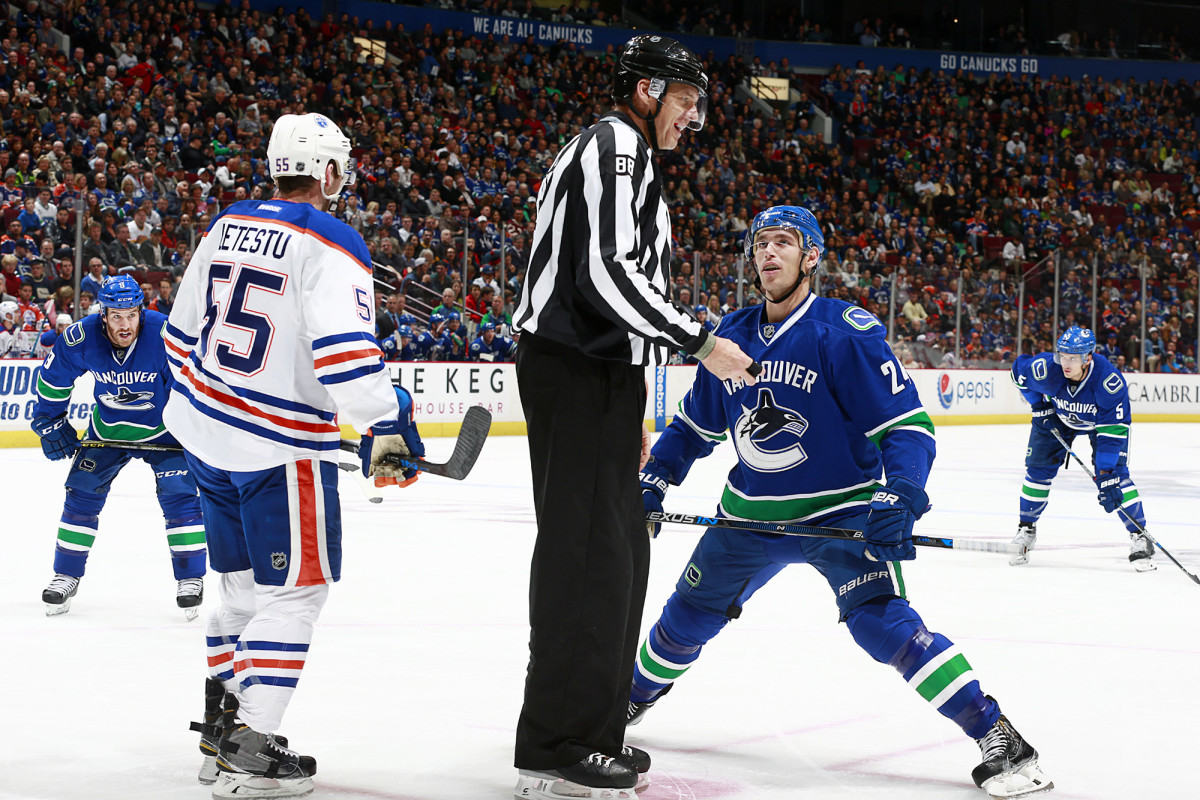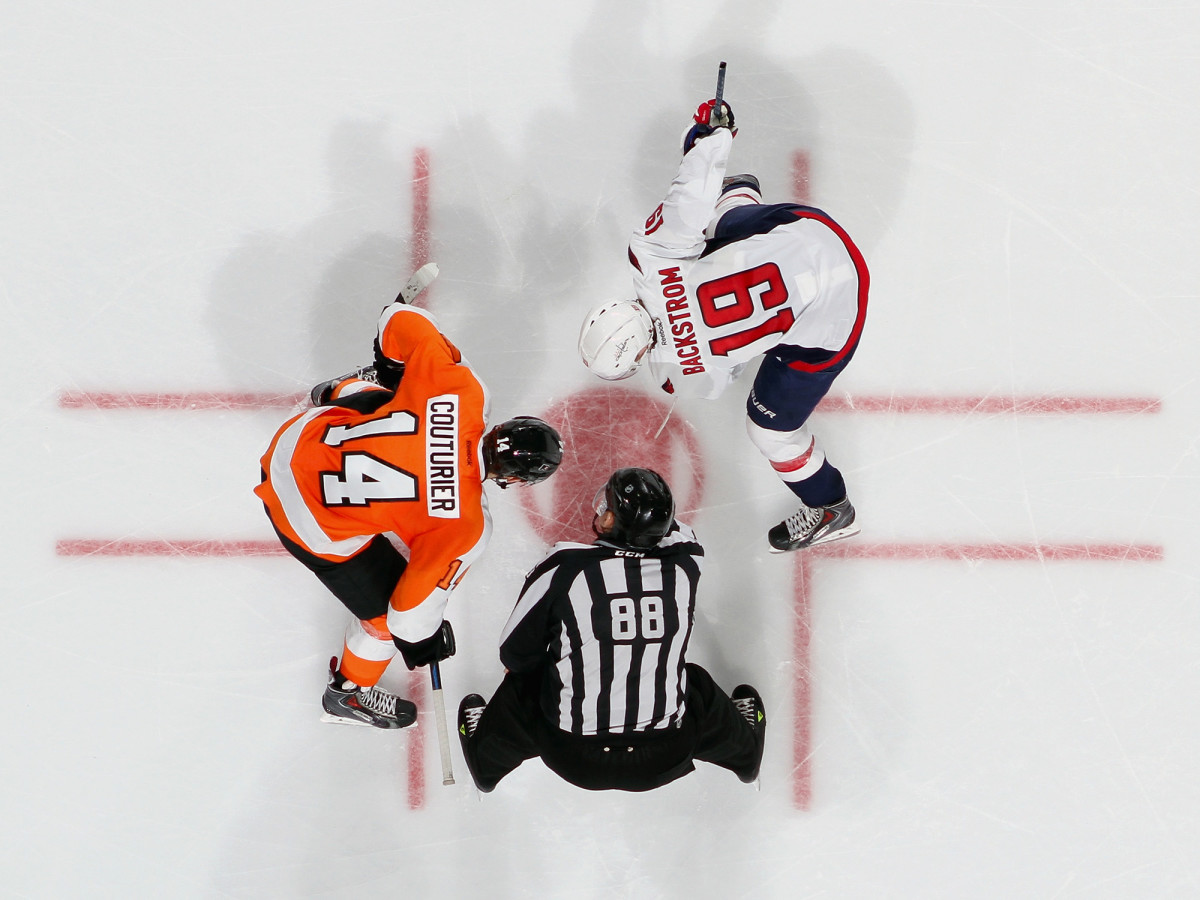How 6'9" longtime NHL linesman Mike Cvik sustained a 29-year career on the ice

Minutes away from the final whistle of Mike Cvik’s 1,868th and last game as an NHL linesman in January, the 53-year-old collapsed to the ice.
Cvik had been saluted moments earlier by 19,000 Calgary Flames fans in his hometown Saddledome as a montage played on the video board. Cvik only saw the end of it, after Flames coach Bruce Hartley interrupted the ref’s water break with an outstretched finger and a suggestion to “look up,” but he heard the public address announcer rattle off the historic stats he’d accrued: a 29-year career; 90 playoff games officiated; All-Star Game, Heritage Classic, and Olympic appearances. During the tribute, Cvik stayed seated along the bench, Gatorade bottle in hand. There would be no victory lap. Not yet at least.
How New York Jets RB Matt Forte withstands football's punishing hits
Ovations for referees are about as common as two-headed goalies, but no one involved in the scene that night seemed to think it an odd way to mark Cvik’s departure. And yet, the reward Cvik got for nearly three decades of service minutes after the send-off was a JT Brown skate to his right leg during an otherwise normal rush, which sent the official to the ice, sprawled on his backside. When Cvik did gather himself, he registered a new pain in his ankle. It was far from the first injury Cvik had sustained in his line of work. His nose had been broken over the years, his mouth bloodied and his hand crippled so badly it still can’t be closed into his fist. He was even nursing a knee injury that night in Calgary. So Cvik took the newest blow in turn, shaking it off and carrying on with work. When fellow linesman Brian Murphy skated over and suggested Cvik get medical attention, he was brushed off. “Is my bone sticking out?” Cvik responded. “I’m staying out here.”
Eight months later, he is still recovering from what turned out to be a spiral fracture. Every day, he straps on a bulky bone stimulator, which has helped him avoid surgery. But he does not regret his decision. “I’ll never forget my last game now,” he says with a laugh. Plus, the fluke injury allowed Cvik to exit the league as he entered it: a tough man dedicated to the game.

Cvik quickly rose through the minor ranks after getting noticed calling local games, and he made his NHL debut in 1987. He still remembers the date when the head of officiating called to ask if he was interested in the gig—August 22. In his Canadian accent, Cvik responded without hesitation, “Oh yeah.”
His 6’9” frame was an asset in the NHL’s haymaker heyday, and Cvik often drew assignments where fights were certain to erupt. He figured out how to lay his hands over brawlers’ arms to prevent them from throwing punches, and, after catching an incidental hook from Shawn Cronin that broke his nose, made sure his partner was ready before breaking up any fracas. “I learned that as much as I thought I was Superman,” Cvik says, “I was not.”
Then he had to adjust again as the league’s players got smaller and faster and its brawlers fell by the wayside. To keep up, Cvik sought out a trainer to update his workout routine. After years of powerlifting—heavy rotations of shoulder presses, pull downs, and the like, starting with a 195-pound bench press warmup set—Cvik’s trainer transitioned him to more lower body and core work: change of direction drills, box jumps, and a warm-up bench press set at 90 pounds. “I was like, ‘Seriously dude? I do that with one arm,” Cvik recalled.
Adjusting his mindset was tough, but not as hard as sticking to his new diet. “I had been eating five to six times a day, eating upwards of 6,000 calories,” Cvik said. “I had to go from 6,000 down to 3,500.” Twelve ounces of turkey became six, and beers and burgers during golfing trips were replaced by the jeers Cvik received when he pulled rice and carrots out his backpack. Ultimately, he lost nearly 40 pounds. “I believe that lengthened my career,” Cvik said.
Sweat Mecca: Once America’s largest bank hall is now Under Armour's deposit in fitness
All of his work was validated when he was called upon to officiate the 2002 Olympics gold medal game. After Canada won, its coach, the late Pat Quinn, walked down the ice towards Cvik, who wondered what he might have to complain about after the victory. “I just wanted to say you guys did a really good job tonight,” he said. “Thanks, Pat,” Cvik responded. “So does this mean you’re not going to yell at me anymore?” “Hell no,” Quinn shot back.
With his ankle still healing, Cvik has had to cut back on his workout regimen since the season ended. He has compensated by doing yard work around his house in Calgary and keeping up with his four daughters and seven grandchildren. He’s planning to stay involved with hockey as either a mentor for NHL refs or as a supervisor in nearby leagues. Either way, he’ll serve as an example for the next generation of skating zebras.
The catcher position is unique, so the Royals' trainer uses an individualized approach
After his final game in January, Cvik glided off the rink only to be stopped by his fellow officials halfway into the tunnel. When he heard the public address announcer begin to name the night’s three stars, he figured out why his colleagues had been so insistent. He turned back, preparing to hear his name called as the third star of the night, likely the first official to ever receive the honor. Then, even on a broken ankle, he hopped back onto the ice for one more skate.
Three tips to break up a fight

Don't go in alone
Make sure you have a partner to help you separate any potential combatants, and ensure you are on the same page about when and how to intervene.
Hug from above, not below
The faster you can contain their arms, the faster peace can be restored.
Communicate
Often times, the heat of the moment can prevent someone from recognizing your peace-keeping role. Tell them why you're there, and don't be afraid to keep the mood light. I like to say, "How are your knuckles feeling?" Other times, you'll have to remind them about the potential consequences of their aggression.
